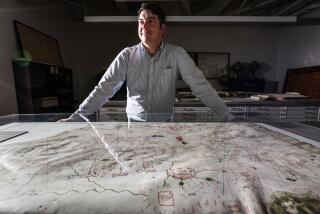Computers at Exhibit Offer View Into the Past
- Share via
At the touch of a key, the glowing image of an ancient manuscript appeared on one of the large computers arranged in a room at the Huntington Library. The letter, stained and yellow, was illegible to everyone clustered around the screen.
But with a few clicks of a computer mouse, operator Cristina Garcia removed the splotches and restored the document’s original crisp Spanish script.
Students and other onlookers buzzed in surprise as another keystroke brought to the screen a colorful, centuries-old trading map of the Americas. The computer, linked to an archive in Spain, zoomed in on areas of the illustration and enlarged tiny details.
On another side of the library, a quiet, dimly lit room housed about 50 rare books, charts and manuscripts. Visitors looked at the delicate items encased in glass, including a rare trade chart of the Americas from 1502, a 1524 map of Tenochtitlan sent to the Spanish emperor by Hernan Cortes and accounts of explorations made by Cortes and Francisco Pizarro.
The Huntington exhibit, “Spain in the Americas, 1492-1600: What is the Legacy?” combines both ancient works and cutting-edge technology to present perspectives on Spain’s role in the Americas, and coincides with the 500th anniversary of Christopher Columbus’ arrival in the Western Hemisphere.
Documents from Spain make up most of the collection, although library docents stress the importance of seeing the conquest from both European and American points of view.
“We can’t tell you for certain what happened,” said Diane Morris, a Huntington docent, gesturing to a map of the Old World. She encouraged students to look around and interpret the rare material while keeping in mind the writers’ European backgrounds.
“We came (to the library) to see the Aztec Empire,” said Victor Robles, one of two students from Centennial High School in Corona who were preparing a presentation on the Aztecs for a statewide History Day competition. “But the stuff here is biased by the European view,” Robles said.
“But the accounts that were kept (preserved since that period) were mostly Spanish, so what do you expect?” responded Lisa Scoville, a 16-year-old Centennial student who traces her roots to Spain.
The library provides educational materials to schools to prepare students for the exhibition, which was funded by the Ramon Areces Foundation of Spain. More than 4,000 students from 60 Southland schools are scheduled to see the exhibit at the San Marino library before it closes in October.
Among the most popular features of the exhibit is the Archivo Computerization Project, said Enriqueta Thomas, education assistant with the Volunteer and Tour Activities department. The computer system is linked to the Archivo General de Indias in Seville, Spain, allowing researchers to examine any of 11 million original documents.
“Today you can review the books with new technology,” said Thomas. “(Young people) relate to it better since the material is on the computer.”
“You can read about things in a textbook, but here they have the original writings,” said Michael Pasikov, a Centennial junior. “And the computers--they were amazing.”
The exhibit was first proposed in 1986 by William Frank, Spanish-American history curator at the library. “We’re trying to look at the interactions between the cultures here . . . how they came to terms with each other and the impact they had on each other,” Frank said. One of the rarest documents in the exhibition is known as the Columbus memorial of 1502, the oldest known text of a letter that Columbus wrote to his son, Diego. Thought to be lost, the manuscript was recently found in the back of a 17th-Century book in the library’s collection.
More to Read
Sign up for Essential California
The most important California stories and recommendations in your inbox every morning.
You may occasionally receive promotional content from the Los Angeles Times.













